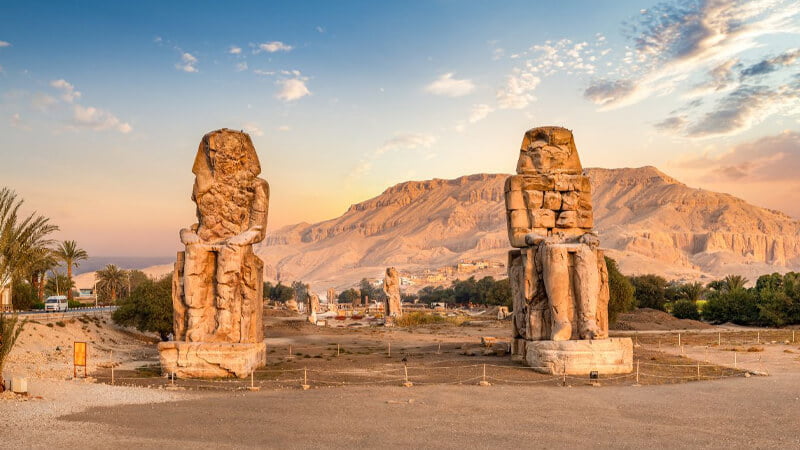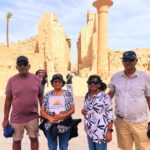The Colossi of Memnon are among the most fascinating monuments in ancient Egypt. Standing silently on the west bank of the Nile near Luxor, these massive statues have watched over the landscape for more than 3,400 years. Travelers, historians, and archaeologists alike are drawn to their scale, mystery, and the legends that surround them. More than just stone figures, the Colossi of Memnon tell a powerful story about ancient Egyptian architecture, royal ambition, and cultural memory.
This in-depth guide explores everything you need to know about the Colossi of Memnon, including their history, purpose, interior design, reconstruction efforts, and the famous “singing” sound that once made them legendary.
What Are the Colossi of Memnon?
Memnon Colossi are two gigantic stone statues depicting Pharaoh Amenhotep III, one of the most powerful rulers of Egypt’s 18th Dynasty. Each statue sits on a throne and faces east toward the rising sun and the Nile River.
How Many Colossi of Memnon Statues Exist?
There are two statues, commonly referred to as the Colossi of Memnon. Although they appear similar, each statue has unique details carved into the throne and base, including images of the pharaoh’s family and symbolic representations of unity in ancient Egypt.
History of the Memnon Colossi
The Colossi were built around 1350 BCE during the reign of Amenhotep III. They once stood at the entrance of his vast mortuary temple, which was one of the largest and most impressive temple complexes ever constructed in ancient Egypt.
Colossi of Memnon Story Through Time
Originally, these statues were purely Egyptian in meaning. However, centuries later, Greek and Roman travelers reinterpreted them through their own myths. The name “Memnon” comes from a legendary Ethiopian king in Greek mythology who was killed during the Trojan War. According to legend, the statue’s mysterious sound at dawn was Memnon greeting his mother, the goddess of the dawn.
This blending of Egyptian history and Greek mythology transformed the Memnon Colossi into one of the most famous monuments of the ancient world.

Architecture and Design of the Colossi of Memnon
The architecture of the Memnon Colossi reflects the ambition and technical skill of ancient Egyptian builders. Each statue stands about 18 meters (60 feet) tall and weighs an estimated 720 tons.
Materials and Construction
The statues were carved from single blocks of quartzite sandstone quarried near modern-day Cairo, over 675 kilometers away. Transporting stones of this size across Egypt without modern machinery remains one of the most impressive engineering achievements of antiquity.
Artistic Details
Amenhotep III is shown seated, with his hands resting on his knees, wearing the traditional nemes headdress. Smaller figures carved into the throne represent his wife Queen Tiye and his mother Mutemwiya, emphasizing royal lineage and divine legitimacy.
Purpose of the Colossi of Memnon
Understanding the purpose of the Memnon Colossi helps explain their immense size and symbolic power. These statues were designed to serve as guardians of Amenhotep III’s mortuary temple.
Religious and Symbolic Meaning
In ancient Egyptian belief, mortuary temples were places where the pharaoh’s spirit could receive offerings and maintain divine status in the afterlife. The Memnon Colossi symbolized royal authority, protection, and the eternal presence of the king.
Facing the rising sun, the statues were also associated with rebirth and regeneration—key themes in Egyptian religion.
Why Is the Colossus of Memnon Important?
Many visitors ask, Why is the Memnon Colossus important? Their significance goes far beyond their size.
- They are among the largest statues ever created in ancient Egypt
- They provide insight into the reign of Amenhotep III, a golden age of prosperity
- They influenced Greek and Roman writers, artists, and travelers
- They demonstrate advanced ancient engineering techniques
Even after the mortuary temple was destroyed by floods and earthquakes, the statues remained standing, becoming enduring symbols of Egypt’s ancient power.
The Famous Memnon Colossi Sound
One of the most intriguing aspects of these statues is the legendary sound. After an earthquake in 27 BCE damaged the northern statue, visitors reported hearing a mysterious sound at sunrise.
What Caused the Sound?
Ancient writers described the sound as a musical tone, whisper, or cry. Modern scholars believe it was caused by changes in temperature at dawn. As the stone warmed, moisture trapped inside cracks evaporated, producing vibrations.
Cultural Impact of the Sound
The sound made the Colossi of Memnon a major tourist attraction in Roman times. Emperors, poets, and scholars traveled great distances to hear it. Inscriptions carved into the statue record these visits, making it one of the earliest examples of “tourist graffiti” in history.

Colossi of Memnon Reconstruction and Restoration
Over the centuries, natural disasters caused significant damage to the statues. The most notable reconstruction took place during the Roman period.
Roman Restoration Efforts
In the 3rd century CE, Roman Emperor Septimius Severus ordered repairs to the damaged northern statue. While the restoration stabilized the monument, it also silenced the famous sound forever.
Modern Conservation
Today, Egyptian authorities and international teams continue to monitor and preserve the statues. Conservation efforts focus on protecting them from environmental damage while maintaining their historical authenticity.
Interior and Structural Insights
Although they appear solid from the outside, their interior structure is key to understanding their durability and damage.
Internal Cracks and Layers
The statues are carved from layered quartzite sandstone, which explains why they cracked during earthquakes. These internal fissures played a major role in producing the mysterious sound heard in antiquity.
Engineering Precision
Despite their size, the statues were carefully balanced and aligned. This precision allowed them to survive thousands of years of flooding from the Nile and shifting ground conditions.
Fascinating Facts About the Colossi of Memnon
- Each statue weighs approximately 720 tons
- They are older than the Parthenon by nearly 1,000 years
- The mortuary temple they once guarded was larger than the Karnak Temple
- Ancient travelers left over 100 inscriptions on the statues
- The statues once stood at the edge of fertile land, not in the desert
These facts highlight why they remain one of Egypt’s most remarkable monuments.
Visiting the Colossi of Memnon Today
Today, the Memnon Colossi are one of the most accessible ancient sites in Luxor. Located near the Valley of the Kings, they are often the first stop on the West Bank.
Best Time to Visit Clossi of Memnon: Early morning or late afternoon visits are ideal. The soft light enhances the statues’ details and helps visitors imagine how awe-inspiring they must have been in ancient times.
What to Expect: While only the statues remain, informational signs and nearby archaeological work help visitors understand the original scale of the site and its importance.
Legacy of the Colossi of Memnon
They are more than ruins—they are storytellers. Through their size, legends, and survival, they connect modern visitors to ancient beliefs about power, immortality, and art.
From the story rooted in Egyptian religion to the mysterious celebrations by Roman emperors, these statues continue to inspire curiosity and wonder.
Conclusion
They stand as timeless guardians of ancient Egypt’s past. Their architecture showcases remarkable engineering, their history reveals cultural exchange between civilizations, and their purpose reflects deep spiritual beliefs. Whether you are drawn by the mystery of the singing statues, the scale of their construction, or their enduring symbolism, they remain one of the most important and unforgettable monuments in Egypt. For anyone interested in ancient history, archaeology, or cultural heritage, a deeper understanding offers a powerful glimpse into the grandeur of the ancient world.




